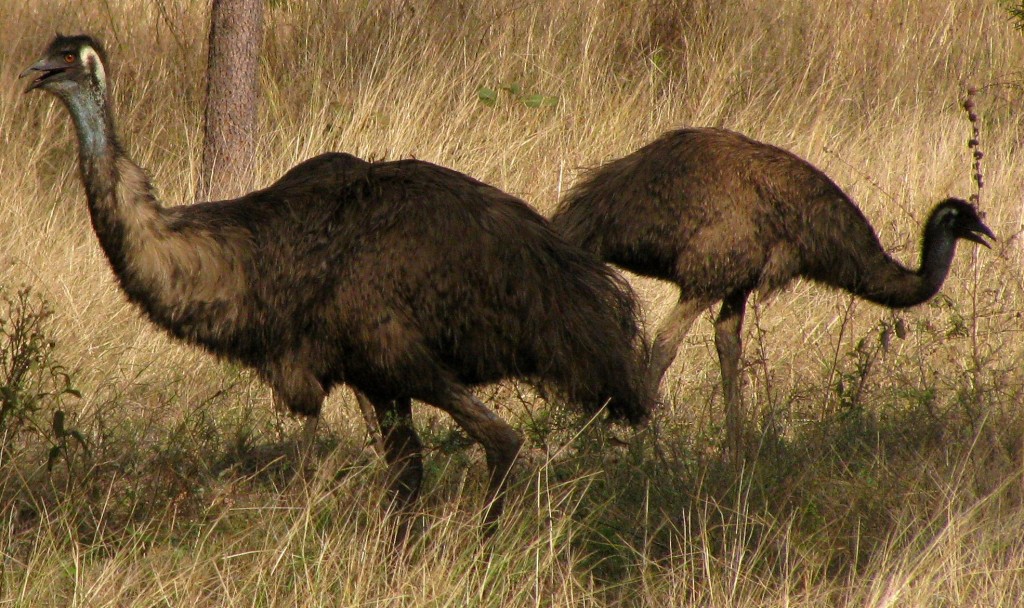
Male Emu and Young in Savannah near Ravenswood, Queensland (© Vilis Nams)
Yesterday, I was thrilled when I spotted three emus peacefully strolling over a grassy highway verge near Ravenswood in north Queenslad. However, as Vilis and I quietly walked alongside them at the edge of the savannah woodland, I realized I didn’t know much about emus other than the fact that they are Australia’s largest native bird and another of its iconic animals, along with those koalas and kangaroos. So, I did a little research.
I learned that emus belong to the same avian family as southern cassowaries, the Casuariidae, and that these sturdy-legged, flightless birds of plains and woodlands are next in size to ostriches, making them the world’s second-largest living bird species.1 When Europeans invaded/colonized Terra Australis in the late 1700’s, they encountered three species of emus, the present species, Dromaius novaehollandiae, on the mainland and Tasmania, and two other distinct species on King and Kangaroo Islands, respectively.2 Today, emus occur throughout mainland Australia with the exception of heavily populated regions and the driest of deserts, but due to overhunting by Europeans are now extinct on King and Kangaroo Islands and in Tasmania (although Vilis and I did observe a pair of introduced birds on a grassy property near Freycinet National Park in Tassie).2
The powerful legs of emus allow them to gallop at high speeds up to 50 kph over short distances, and to swim well.3 Their feathers form a thick, loose plumage and appear to be incredibly soft. They’re divided into fine strands3 and drape from the emus’ bodies like soft stoles of grey and black. (As an aside, in the Canterbury Museum in Christchurch, New Zealand, a display of the extinct giant moa was created using emu feathers in place of those of moas, which are unfortunately no longer alive after being hunted to extinction by the Maori five hundred or so years ago.) Whereas adult emus possess a rather plain plumage, newly-hatched young have spotted heads and are camouflaged in a striped plumage of greyish-brown and buff, which allows them to blend in with the tawny vegetation of their surroundings.3
Emus breed during the Australian winter and spring, with the female laying 6 to 11 large green eggs with pebbled shells. After doing her part, the female leaves the male to incubate the eggs and watch over the young, which he does for a period of 18 to 24 months.3 Thus, the adult bird Vilis and I observed yesterday was undoubtedly a male guiding his pair of offspring through the savannah, showing them the ropes of emu life. It was fascinating (and relieving) that whereas the male responded agressively to a second adult which ran into the forest from across the road – galloping away from his young with his loose plumage bouncing in order to chase the intruder away – he showed only curiosity toward Vilis and me.
Emus eat a variety of foods including insects, grasses and herbs, grains, leaves, berries, flowers, and carrion1 and can employ a delicate precision in obtaining food. I observed this ten years ago in a wildlife park near Port MacQuarrie in New South Wales, when a much younger edition of my son Janis offered a tall, elegant emu gobbler some puffed rice held out on his small hand. With his muscular neck rippling, the gobbler bobbed his head back and forth high above Janis, and then delicately plucked the food from the raised palm, much to my son’s delight.
Emus, like the extinct moas of New Zealand, can’t clip off vegetation as a kangaroo or rabbit does; rather, they pull it off. And emus share another feeding trait with the moas, that of not being able to push food back with their tongues. Instead, they jerk their heads back and forth to get it down. This Vilis explained to ours sons and me after attending a seminar at Lincoln University (when we lived in New Zealand) given by a South African scientist who used emus to simulate moa grazing habits in order to study the architecture of plants as a means of survival against moa grazing. Totally caught up in his excitement from the seminar, Vilis imitated the scientist imitating an emu tossing its head back and forth, trying to swallow a strip of plant tissue. His performance was most illuminating, and was clearly echoed by the emu which swallowed Janis’s rice puffs.
References:
1. Graham Pizzey and Frank Knight. The Field Guide to the Birds of Australia. 1997. Angus & Robertson, Sydney, p. 521; 2. Ibid, pp. 18, 521; 3. Ibid, p. 18.


